The Polysaccharide Films Market is estimated to be valued at USD 1.4 billion in 2025 and is projected to reach USD 2.4 billion by 2035, registering a compound annual growth rate (CAGR) of 5.4% over the forecast period.
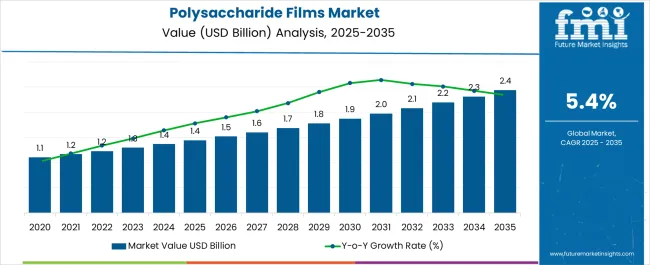
| Metric | Value |
|---|---|
| Polysaccharide Films Market Estimated Value in (2025 E) | USD 1.4 billion |
| Polysaccharide Films Market Forecast Value in (2035 F) | USD 2.4 billion |
| Forecast CAGR (2025 to 2035) | 5.4% |
The Polysaccharide Films market is expanding steadily, supported by the growing demand for sustainable packaging solutions and the transition away from conventional petroleum-based plastics. Increasing consumer awareness around eco-friendly materials, along with policy-level support for biodegradable alternatives, has positioned polysaccharide-based films as a viable replacement in multiple industries. Advances in material science are enabling the development of films with enhanced mechanical strength, water resistance, and barrier properties, making them suitable for food packaging, pharmaceuticals, and agricultural applications.
The current market is characterized by strong adoption in food-related sectors where biodegradable packaging is gaining regulatory and consumer traction. Cost optimization strategies and innovations in film processing technology are further supporting scalability.
Looking ahead, opportunities are anticipated from continuous research into blending polysaccharides with other biopolymers to improve durability and functional versatility The outlook for the market remains optimistic as industries align with circular economy goals and sustainability commitments, creating a favorable environment for widespread adoption of polysaccharide films across both developed and emerging economies.
The polysaccharide films market is segmented by material, thickness, applications, and geographic regions. By material, polysaccharide films market is divided into Starch, Alginate, Carrageenan, Cellulose Derivatives, Pectin, Agar, Chitin/Chitosan, and Gums. In terms of thickness, polysaccharide films market is classified into Up To 50 µm, 50-100 µm, 100-200 µm, and 200 µm & Above. Based on applications, polysaccharide films market is segmented into Food, Meat & Poultry, Seafood, Ready-To-Eat Food, Dairy Products, Nutritional Products, Vegetables & Fruits, and Pharmaceuticals. Regionally, the polysaccharide films industry is classified into North America, Latin America, Western Europe, Eastern Europe, Balkan & Baltic Countries, Russia & Belarus, Central Asia, East Asia, South Asia & Pacific, and the Middle East & Africa.
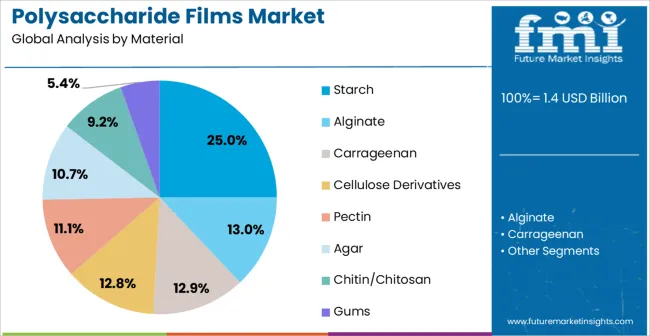
The starch material segment is projected to account for 25.00% of the Polysaccharide Films market revenue in 2025, making it a leading contributor among material types. This segment’s growth is being driven by the abundance and cost-effectiveness of starch, which is derived from renewable sources such as corn, potatoes, and cassava. The biodegradability of starch-based films has positioned them as a preferred choice in packaging applications where environmental impact reduction is prioritized.
Starch offers favorable film-forming properties and compatibility with additives, enabling the production of films with improved flexibility, transparency, and tensile strength. Adoption has been further supported by regulatory frameworks encouraging the replacement of single-use plastics with biodegradable alternatives.
The scalability of starch extraction and processing has also enabled large-scale production at competitive costs, making it commercially viable As consumer preference continues to shift towards eco-conscious products, the starch segment is expected to sustain growth, with increasing application in packaging, disposable items, and coatings where performance and sustainability are equally valued.
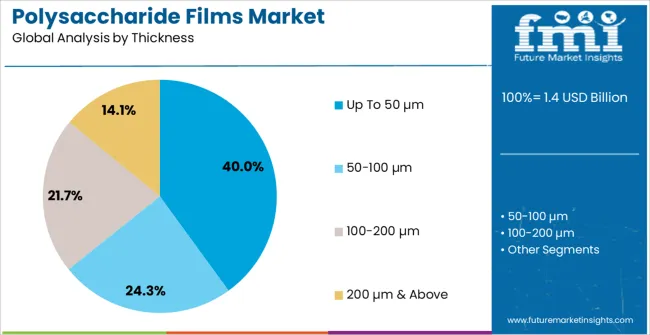
The Up To 50 µm thickness category is anticipated to hold 40.00% of the Polysaccharide Films market revenue in 2025, securing the leading share in the thickness segment. This dominance is being attributed to the balance these films achieve between functionality, cost, and material efficiency. Films within this thickness range are widely adopted in food packaging and coating applications, where flexibility, clarity, and sufficient barrier properties are critical.
Their lightweight nature reduces material usage and overall costs while maintaining performance standards required by regulatory authorities and end-users. The ease of processing and the ability to integrate with conventional film manufacturing equipment have further accelerated adoption.
Additionally, thinner films align with sustainability objectives as they reduce raw material consumption and enhance biodegradability rates With industries such as food and consumer goods increasingly seeking alternatives to petroleum-derived plastics, the preference for films up to 50 µm in thickness is expected to continue expanding, supported by innovations in formulation and performance optimization.
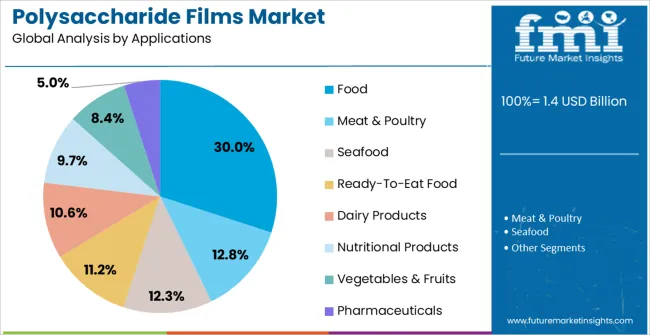
The food application segment is expected to account for 30.00% of the Polysaccharide Films market revenue in 2025, making it the largest application category. This growth is being driven by the increasing adoption of biodegradable films as primary and secondary packaging in the food industry. Rising consumer demand for safe, sustainable, and environmentally friendly packaging materials has been instrumental in positioning polysaccharide films as a key solution.
These films provide adequate barrier properties against oxygen and carbon dioxide, thereby extending shelf life while reducing reliance on synthetic plastics. The alignment of food companies with global sustainability initiatives has further boosted demand for polysaccharide-based solutions. Cost competitiveness, coupled with improvements in mechanical and moisture resistance, has made these films suitable for a variety of food products ranging from fresh produce to processed goods.
Regulatory mandates discouraging the use of single-use plastics in food packaging are also acting as a catalyst for adoption The food segment is expected to remain at the forefront of market growth, given its direct consumer impact and regulatory support for biodegradable packaging solutions.
Polysaccharide films are made from starch alginate, cellulose ethers,chitosan, carrageenan or pectin and are used for food packaging applications. Polysaccharide films impart hardness, compactness thickening quality, adhesiveness and gel forming ability.
The polymer chains making up the polysaccharide film exhibit excellent gas barrier properties resulting in desirable modified atmospheres that enhance the shelf life of the product. Polysaccharide films are mainly used for food applications especially for muscle foods.
Polysaccharide films are used to extend the shelf life of the muscle foods by preventing dehydration and surface browning. Types of Polysaccharide films include starch based, alginate, carrageenan, cellulose derivatives, pectin, agar, chitosan and gums.
These polysaccharide films are able to provide good barrier properties against oxygen and carbon dioxide. Desired tensile strength values are required to maintain the integrity of the packaged food. The tensile strength values provided by the polysaccharide films are comparable to those values found in high density polyethylene films.
Researchers nowadays are studying the combinations of polysaccharides with other materials to improve the barrier and mechanical properties. Polysaccharide films made from chitosan are also being studied for antimicrobial properties.
The use of synthetic plastics in the packaging of food is causing a critical environmental problem. Considering the harmful impacts of plastic films on environment manufacturers are focusing on producing biodegradable films and coatings. The high demand for biodegradable films for food packaging is expected to drive the global polysaccharide films market during the forecast period.
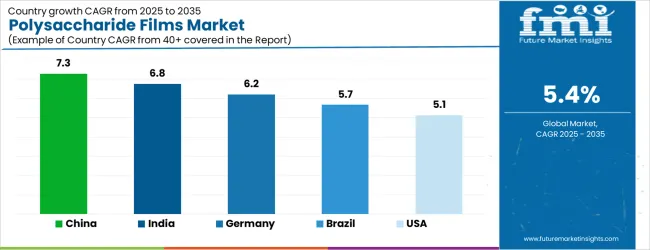
| Country | CAGR |
|---|---|
| China | 7.3% |
| India | 6.8% |
| Germany | 6.2% |
| Brazil | 5.7% |
| USA | 5.1% |
| UK | 4.6% |
| Japan | 4.1% |
The Polysaccharide Films Market is expected to register a CAGR of 5.4% during the forecast period, exhibiting varied country level momentum. China leads with the highest CAGR of 7.3%, followed by India at 6.8%. Developed markets such as Germany, France, and the UK continue to expand steadily, while the USA is likely to grow at consistent rates. Japan posts the lowest CAGR at 4.1%, yet still underscores a broadly positive trajectory for the global Polysaccharide Films Market. In 2024, Germany held a dominant revenue in the Western Europe market and is expected to grow with a CAGR of 6.2%. The USA Polysaccharide Films Market is estimated to be valued at USD 490.3 million in 2025 and is anticipated to reach a valuation of USD 490.3 million by 2035. Sales are projected to rise at a CAGR of 0.0% over the forecast period between 2025 and 2035. While Japan and South Korea markets are estimated to be valued at USD 67.0 million and USD 36.9 million respectively in 2025.
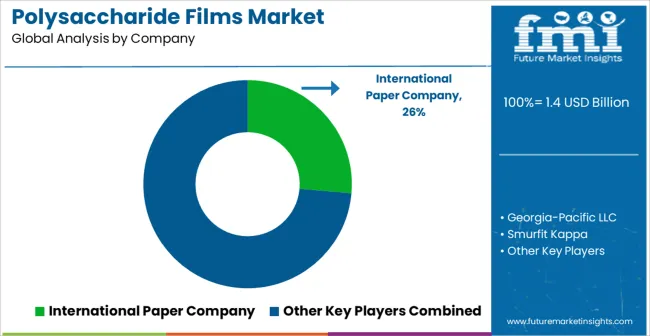
| Item | Value |
|---|---|
| Quantitative Units | USD 1.4 Billion |
| Material | Starch, Alginate, Carrageenan, Cellulose Derivatives, Pectin, Agar, Chitin/Chitosan, and Gums |
| Thickness | Up To 50 µm, 50-100 µm, 100-200 µm, and 200 µm & Above |
| Applications | Food, Meat & Poultry, Seafood, Ready-To-Eat Food, Dairy Products, Nutritional Products, Vegetables & Fruits, and Pharmaceuticals |
| Regions Covered | North America, Europe, Asia-Pacific, Latin America, Middle East & Africa |
| Country Covered | United States, Canada, Germany, France, United Kingdom, China, Japan, India, Brazil, South Africa |
| Key Companies Profiled | International Paper Company, Georgia-Pacific LLC, Smurfit Kappa, Mondi Group, Amcor Limited, Nichols Paper Products Company, Inc., Uflex Ltd., Moore Packaging Corporation, and Dynapac Co., Ltd. |
The global polysaccharide films market is estimated to be valued at USD 1.4 billion in 2025.
The market size for the polysaccharide films market is projected to reach USD 2.4 billion by 2035.
The polysaccharide films market is expected to grow at a 5.4% CAGR between 2025 and 2035.
The key product types in polysaccharide films market are starch, alginate, carrageenan, cellulose derivatives, pectin, agar, chitin/chitosan and gums.
In terms of thickness, up to 50 µm segment to command 40.0% share in the polysaccharide films market in 2025.






Our Research Products

The "Full Research Suite" delivers actionable market intel, deep dives on markets or technologies, so clients act faster, cut risk, and unlock growth.

The Leaderboard benchmarks and ranks top vendors, classifying them as Established Leaders, Leading Challengers, or Disruptors & Challengers.

Locates where complements amplify value and substitutes erode it, forecasting net impact by horizon

We deliver granular, decision-grade intel: market sizing, 5-year forecasts, pricing, adoption, usage, revenue, and operational KPIs—plus competitor tracking, regulation, and value chains—across 60 countries broadly.

Spot the shifts before they hit your P&L. We track inflection points, adoption curves, pricing moves, and ecosystem plays to show where demand is heading, why it is changing, and what to do next across high-growth markets and disruptive tech

Real-time reads of user behavior. We track shifting priorities, perceptions of today’s and next-gen services, and provider experience, then pace how fast tech moves from trial to adoption, blending buyer, consumer, and channel inputs with social signals (#WhySwitch, #UX).

Partner with our analyst team to build a custom report designed around your business priorities. From analysing market trends to assessing competitors or crafting bespoke datasets, we tailor insights to your needs.
Supplier Intelligence
Discovery & Profiling
Capacity & Footprint
Performance & Risk
Compliance & Governance
Commercial Readiness
Who Supplies Whom
Scorecards & Shortlists
Playbooks & Docs
Category Intelligence
Definition & Scope
Demand & Use Cases
Cost Drivers
Market Structure
Supply Chain Map
Trade & Policy
Operating Norms
Deliverables
Buyer Intelligence
Account Basics
Spend & Scope
Procurement Model
Vendor Requirements
Terms & Policies
Entry Strategy
Pain Points & Triggers
Outputs
Pricing Analysis
Benchmarks
Trends
Should-Cost
Indexation
Landed Cost
Commercial Terms
Deliverables
Brand Analysis
Positioning & Value Prop
Share & Presence
Customer Evidence
Go-to-Market
Digital & Reputation
Compliance & Trust
KPIs & Gaps
Outputs
Full Research Suite comprises of:
Market outlook & trends analysis
Interviews & case studies
Strategic recommendations
Vendor profiles & capabilities analysis
5-year forecasts
8 regions and 60+ country-level data splits
Market segment data splits
12 months of continuous data updates
DELIVERED AS:
PDF EXCEL ONLINE
TPE Films and Sheets Market Size and Share Forecast Outlook 2025 to 2035
Breaking Down PCR Films Market Share & Industry Positioning
PCR Films Market Analysis by PET, PS, PVC Through 2035
Soy Polysaccharides Market
LDPE Films Market
Card Films Market
Mulch Films Market Size and Share Forecast Outlook 2025 to 2035
Nylon Films for Liquid Packaging Market from 2024 to 2034
Vinyl Films Market
MDO-PE Films Market Analysis by Cast Films and Blown Films Through 2035
Edible Films and Coatings Market Growth - Trends & Forecast 2025 to 2035
Market Share Breakdown of Edible Films and Coatings
Retort Films Market
Tobacco Films Market Size and Share Forecast Outlook 2025 to 2035
Gelatin Films Market Size and Share Forecast Outlook 2025 to 2035
Lidding Films Market Size and Share Forecast Outlook 2025 to 2035
Optical Films Market Size and Share Forecast Outlook 2025 to 2035
Stretch Films Market Outlook - Size, Demand & Industry Trends 2025 to 2035
Protein Films Market from 2024 to 2034
PE Foam Films Market

Thank you!
You will receive an email from our Business Development Manager. Please be sure to check your SPAM/JUNK folder too.
Chat With
MaRIA